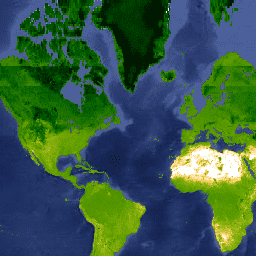
- Dostępność zbioru danych
- 2001-02-01T00:00:00Z–2015-01-01T00:00:00Z
- Dostawca zbioru danych
- Oxford Malaria Atlas Project
- Cykl
- 1 miesiąc
- Tagi
Opis
Ten zbiór danych dotyczący wilgotności w transformacji Tasseled Cap (TCW) został utworzony przez zastosowanie równań transformacji Tasseled Cap zdefiniowanych w artykule Lobser i Cohen (2007) do obrazów MODIS skorygowanych pod kątem BRDF (MCD43B4). Wynikowe dane zostały uzupełnione zgodnie z metodą opisaną w artykule Weiss i wsp. (2014) w celu wyeliminowania brakujących danych spowodowanych czynnikami takimi jak zachmurzenie. Następnie dane zostały zagregowane w czasie i przestrzeni, aby uzyskać miesięczny produkt o rozdzielczości ok. 5 km.
Ten zbiór danych został opracowany przez Harry’ego Gibsona i Daniela Weissa z Malaria Atlas Project (Big Data Institute, University of Oxford, Wielka Brytania, https://malariaatlas.org/).
Pasma
Rozmiar piksela
5000 metrów
Pasma
| Nazwa | Jednostki | Minimum | Maks. | Rozmiar piksela | Opis |
|---|---|---|---|---|---|
Mean |
-0,84* | 0,96* | metry | Średnia wartość wskaźnika wilgotności Tasseled Cap dla każdego zagregowanego piksela. |
|
FilledProportion |
% | 0* | 100* | metry | Pasek kontroli jakości, który wskazuje odsetek każdego piksela wynikowego, który składał się z danych pierwotnych (w przeciwieństwie do szacunków uzupełniających luki). |
Warunki korzystania z usługi
Warunki korzystania z usługi
Cytaty
Weiss, D.J., P.M. Atkinson, S. Bhatt, B. Mappin, S.I. Hay & P.W. Gething (2014) An effective approach for gap-filling continental scale remotely sensed time-series. ISPRS Journal of Photogrammetry and Remote Sensing, 98, 106–118.
Lobser, S.E. & Cohen, W.B. (2007) MODIS tasselled cap: land cover characteristics expressed through transformed MODIS data. International Journal of Remote Sensing, 28, 5079-5101.
Odkrywanie za pomocą Earth Engine
Edytor kodu (JavaScript)
var dataset = ee.ImageCollection('Oxford/MAP/TCW_5km_Monthly') .filter(ee.Filter.date('2013-01-01', '2013-12-31')); var tcw = dataset.select('Mean'); var tcwVis = { min: -0.6, max: 0.5, palette: [ 'ffffff', 'fcd163', '99b718', '66a000', '3e8601', '207401', '056201', '004c00', '011301' ], }; Map.setCenter(-44.65, 22.59, 2); Map.addLayer(tcw, tcwVis, 'TCW');
